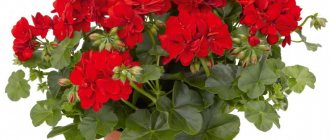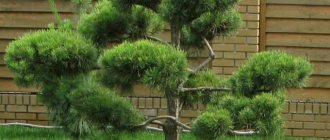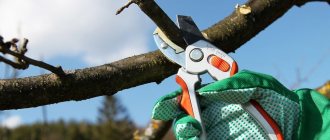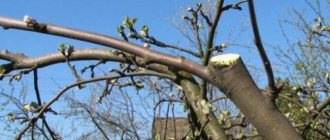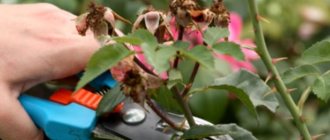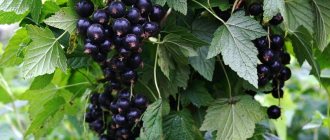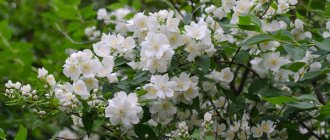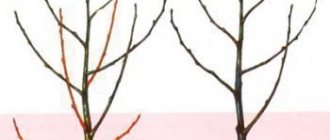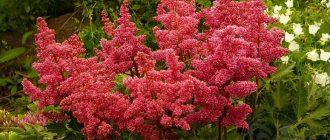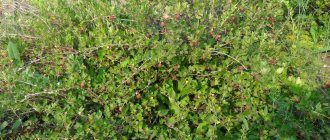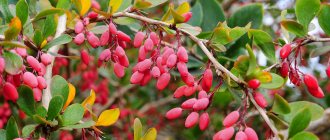Garden and vegetable garden 14
0
It's time for the leaves to fall - it's time to start pruning the bushes. It is clear that each bush requires a special, individual approach, in which the gardener clearly knows where to put a comma in the sacramental phrase: “Pruning cannot be left.” We will only give some general, but very useful tips on pruning the most common shrub plants that are found in most areas.
Types of shrub pruning
Based on the purpose, pruning is divided into the following groups:
- Sanitary.
- Formative.
- Rejuvenating.
Each has its own characteristics, rules and nuances.
Sanitary – for disease prevention
Autumn sanitary pruning is recommended for absolutely all shrubs and trees, fruit and ornamental. The purpose of this event is to prevent the development of all infectious processes, prevent putrefactive formations, and get rid of old, damaged, broken and dry dead branches. After this procedure, the bushes are better ventilated. The branches turned inside the plant are completely removed; unripe ones are cut off at a distance of about 3 cm from the bud.
Shaping - for a beautiful appearance
Formative pruning in late autumn is practiced only for shrubs that bloom in summer. If you do this in the spring, you won’t get a beautiful decorative shape and full flowering. Such plants bloom on last year's branches that have successfully overwintered. These include:
- Japanese quince;
- forsythia;
- mock orange;
- weigela;
- viburnum-leaved bladderwort;
- lilac;
- action;
- spirea;
- three-lobed and steppe almonds.
Formative pruning allows you to transform a simple shrub into a decorative one. To do this, every year, in addition to the main branches, 2-3 new, strongest shoots are left.
Garden plants with a developed root system require special attention: white snowberry, serviceberry, fieldfare. When forming them, control not only the height, but also the width, cutting off the root shoots along the entire perimeter. In young crops it is also very important to prevent excessive crown growth.
On the other hand, you shouldn’t get rid of all the shoots too zealously; this will result in a loose structure and an unsightly appearance of the bush. First of all, old, weak, non-viable branches coming from the roots are cut off. Strong ones are eliminated only in cases where they grow crookedly, towards the bush itself or interfere with the development of young shoots. They leave shoots that can eventually replace old and diseased branches.
In plants that do not tolerate frosty winters well, dried branches must be removed. The cut is made at a distance of 1 cm above the second bud. There will be no need for shoots, branches and shoots that spoil the overall perception of the decorative appearance of the bush.
For bush rejuvenation
Rejuvenating pruning of ornamental shrubs is used to obtain a rich harvest in cases of fruit trees and dense flowering and landscaping for plants that decorate the garden. This method is also suitable for old, poorly growing (less than 6-8 cm per year) crops. The ideal time for the procedure is from August to September.
It is important for novice gardeners to know that pruning is done after flowering. The branches are shortened by 30%, the length is measured from the top. As a result, due to the side shoots, the bush will become more luxuriant, the number of inflorescences will increase, and on fruit bushes the quantity and quality of fruits or berries will increase.
This procedure is carried out every two years. This will allow you to maintain the necessary aeration and decorativeness of the bush.
Scheme for pruning ornamental shrubs according to the rejuvenating type:
Nuances that a gardener needs to know
When performing anti-aging pruning of garden and ornamental crops, you need to take into account some features and consequences. Namely:
- Removing branches, among other benefits, allows you to control the size of the inflorescences. If you greatly shorten the length of the branches, the flowers will become larger, but their number will be significantly reduced.
- If the procedure is carried out regularly, the bush will lose its crown density and its decorative appearance, so shoots intended for removal must be carefully selected.
- No more than 4 buds are cut at a time.
- Branches are radically removed when the plant has significantly degenerated, after 4 years after planting.
- The gardener must know exactly the flowering characteristics of his shrub - whether the buds form on last year’s branches or on fresh growth. Depending on this, old branches or excess growth are cut off.
- In difficult cases, when the bush has stopped producing young shoots, and the old branches are weakened and damaged, a radical rejuvenation procedure is used. Cut off all branches completely at ground level. If the bush was initially formed on a rootstock, pruning is done at a distance of about 15 cm from the grafting. This will activate the growth of fresh shoots, since the base, that is, the root system, will remain the same. After a year or two, the formation of the bush begins again according to the general rules.
Pruning ornamental flowering shrubs in autumn
As for ornamental flowering shrubs, they are also pruned in the fall, getting rid of damaged and missing branches. Formative pruning is carried out only in species that bloom from mid-summer, which form buds on young growth. This applies to paniculate hydrangea, summer spirea, and shrubby cinquefoil. The same bushes that bloom in spring on last year’s branches, for example, clematis of the first pruning group, cannot be touched. Ornamental shrubs that have bloomed all summer on the shoots of the current year will not be affected by autumn pruning, and for some it is even mandatory, for example, buddleia, cinquefoil, fieldfare, etc.
You should always remember that proper pruning is only one of the components of a multifactorial technology for growing ornamental shrubs, which requires the correct choice of location in the garden, proper, timely and regular care:
- watering,
- feeding,
- removing weeds and mulching the soil,
- pest and disease control,
- protection of heat-loving plants for the winter.
Pruning coniferous shrubs
Coniferous shrubs are not pruned regularly. This is justified only in the case of diseased, weak and damaged branches. Another reason is to add a decorative touch to the landscape or use plants as hedges. In order to minimize the traumatic nature of the procedure (conifers are very difficult to tolerate pruning), some features should be taken into account:
- The hardiest type of conifer is the yew. You can form it without fear. All other trees and shrubs must be treated with extreme caution.
- Only the green part is removed; the brown branches should not be touched - they cannot be restored.
- It is important to choose the right tools.
- The safety of the procedure and its effectiveness depend on disinfection.
- No more than 30% of the greenery is removed at a time.
- Cypress and larch trees are pruned in November (the specific time depends on the region).
- The cutting angle for the bud is 45 degrees.
- To preserve the natural appearance, only the internal branches are thinned out.
Some coniferous shrubs lose their attractive, unique coloring with age. Pruning can fix this. For example, the cypress becomes a luxurious plant with a thick, silver-colored crown.
Pruning honeysuckle
When to prune honeysuckle
Many experts believe that honeysuckle does not need pruning until it is 5-7 years old. Honeysuckle bears fruit on annual shoots, but enters full fruiting only in the eighth year of life. It is best to prune honeysuckle in the fall, after the leaves have fallen, but do not delay this procedure until the first snow.
How to prune in autumn
Starting from the eighth year of life, annual thinning and rejuvenating pruning of honeysuckle is carried out, during which the aging and too thick tops of the skeletal branches are removed, gradually strengthening the role of replacement shoots growing in the middle part of the old skeletal branch as new bearing branches. By pruning, the peripheral zone is thinned out. Make sure that the lower parts of the branches are not exposed too much.
In general, on young bushes, slight thinning with shortening of shoots prevails, and fully fruiting bushes are thinned moderately, also slightly shortening the shoots. Old bushes are subject to severe thinning. Leave one third of the fruiting branches without pruning at all, unless it is required for sanitary purposes. Over time - upon reaching 8-10 years of age - these branches are cut one by one “to the stump”.
Necessary tools - types and purpose
“Cutting” is not an easy task and requires the use of well-sharpened garden tools:
- Secateurs. Needed for cutting thin branches up to 2.5 cm in diameter. There are two types of devices - with a curved blade and a straight one. Thick shoots are cut first; the disadvantage is that it is difficult to trim without gaps. The second has a design in which the blade rests against the end of the tool, so there is no need to check for clearance between the blades. The downside is that it is impossible to trim in hard-to-reach places.
- Lopper. Designed for branches with a diameter of 5 cm. Copes well with shoots deep in the leaf crown and other hard-to-reach places. For work at heights there is a rope lopper.
- Saw. Used when eliminating very thick branches.
- Knife. Multifunctional tool. Used for trimming and stripping thin branches, cutting bark, and correcting uneven cuts.
- Garden shears. They help to form a curly crown and hedge.
- Ladder. When choosing it, you should pay attention to stability and widely spaced legs.
Secateurs and other tools for pruning trees and shrubs
You will need two different pruners. The first, also called garden shears, consists of two movable cutting blades and is most often used in everyday gardening work. The second, with a fixed stop-lock, provides the necessary force for pruning and is used to remove large and dead branches.
To trim the hedge, use special mechanical hedge trimmers, or, if it is large, electric hedge trimmers. There are specialized scissors for curly pruning of shrubs. To trim high branches, up to a height of 6 m, use a special tool for remote pruning, it has long handles.
Don't forget that you can always resort to using a regular electric saw or chainsaw, which minimizes the effort required to trim the thickest branches and trunks. Using a hacksaw, you can easily remove old and dried branches by hand. You will also need a small garden knife for processing fresh cuts and cuts.
Before you start pruning, treat the blades of garden tools with a 90º alcohol solution or gasoline - this will prevent pathogens from entering fresh cuts of trees and shrubs. Make sure that the metal parts of the tools do not become rusty. To do this, always remove any remaining plant sap from your work surfaces and lubricate them with machine oil for added protection.
Scheme for proper pruning of ornamental shrubs
The main requirement when pruning is to do no harm. To ensure that the procedure goes without consequences, follow the following rules step by step:
- Dried, damaged, old and broken shoots are removed.
- The cuts are made even; there should be no split stumps.
- If a branch is cut without subsequently leaving a stump, then this is done at an angle of 45 degrees.
- All tools used are thoroughly washed and sharpened.
- For branches up to 2 cm, use pruning shears; thick ones are cut with a hacksaw.
- All actions are carefully verified so as not to affect other shoots.
- If you need to stimulate the growth of weak shoots, cut them shorter. To form a decorative appearance of the bush - only the tops.
- The cut must have a smooth surface.
- To avoid pruning, it is better to simply pinch the shoots in time.
After the procedure, the sections are treated with garden varnish; for thick branches (more than 3 cm in diameter), oil-based paint is used.
How to carry out the procedure for hydrangeas?
Gardeners grow hydrangeas to add decorative beauty to the landscape, so this plant needs pruning to increase the intensity of flowering. Adult cultures aged 5 years and older are subjected to the procedure. Old branches are removed at ground level, cutting them off completely. Leave no more than 5 shoots. If everything is done correctly, in the spring young branches will appear, formed from buds on the root collar. The old ones will be renewed and bloom again.
Another way to renew hydrangea is to remove the buds (faded) at a level of about 40 cm from the soil surface. In this case, in the spring there will be a significant increase in fresh, young shoots on last year’s, quite viable, strong branches. They will not break or sag under the weight of inflorescences and flowering caps.
Blueberry pruning
Blueberry pruning dates
Blueberries bear fruit on last year's shoots. For the first couple of years, blueberries are not pruned at all; in the third year, all fruit buds on the plant are removed. All pruning procedures are carried out after leaf fall.
- Honeysuckle: growing in the garden, types and varieties
Autumn pruning of bushes
In the fourth year from the moment the plant is planted in open ground, that is, when the plant is 5-6 years old, branches that grow too low are cut off from the bush, and small growths are removed around the bush. Three years after planting a blueberry seedling in the garden, annually cut out all the low spreading branches, leaving only upright growth, thin out the middle of the bush, removing all weak, diseased and old branches.
Young shoots that do not have time to grow and strengthen before winter should also be removed. Ideally, you should leave only skeletal branches and strong shoots on the bush, no more than five or six of the annual shoots. Erect blueberry varieties should not be allowed to become too overgrown in the middle, and low-growing branches should be removed from spreading varieties.
Proper pruning of berry bushes
The basis of any garden is berry and fruit trees and shrubs. Growing them is not difficult, but it will take a lot of time and effort. Pruning becomes an important stage of care and must be carried out within a certain time frame and according to established technology.
Autumn “cutting” of fruit and berry crops is carried out annually after the end of sap flow, before the first frost. Depending on the plant species, some perform the procedure in September, others in November. General recommendations are as follows:
- Pruning in autumn is carried out only in regions where there are no long and severe winter frosts. Otherwise, the bark at the cut site will freeze and the bush will die.
- The procedure is not carried out if the outside temperature is less than -10 degrees. In persistent frosts, wood acquires a fragile structure and simply breaks, causing mechanical damage that is difficult to heal.
- Freshly planted shrubs are not pruned, as this is not necessary in the first year. Moreover, if the planting site is chosen incorrectly and the plant is replanted next year, then it is best to form the crown in a new area.
- Autumn pruning applies only to mature trees and shrubs.
- Treatment of cut areas of branches with garden varnish is required.
- Tools must be sharpened as sharply as possible.
Shoots are pruned depending on the species. So, for black currants, the fruiting period lasts about 5 years, so only old branches that are 6 years old are removed.
Raspberries
If the raspberries are not remontant, the procedure is carried out immediately after harvesting. For early varieties, this may even be in the summer. Late-ripening and remontant ones are pruned only in the fall.
The life span of raspberries is 2 years. In the first year the bush actively develops, in the second it bears fruit. Subsequently, the plant begins to degenerate and gradually dies. Therefore, after harvesting for the 2nd year, it is cut off at the root. The number of shoots should also be regulated: the more there are, the smaller the harvest. Ideally, no more than 8 strong and strong shoots are left, the rest are mercilessly removed to the ground.
Remontant raspberries begin to bear fruit in the first year, so they are pruned immediately after harvest. The cut bushes are burned. If the winter in the region has little snow, pruning is carried out by weight. In winter, raspberries are tied in a bunch and bent to the ground.
Currant
Currants are pruned either during berry picking or after, when the bushes have completely shed their leaves and a dormant period begins. It bears fruit both on young shoots and on old branches. But the older the bush, the smaller and smaller the fruits. During the procedure, no more than 10 of the strongest branches and 4 young strong shoots are left on it (5 buds are cut off from the top).
Bushes over 6 years old are removed to the first true bud, which is about a third of the branch. Dried ones are cut out completely. Young shoots at the roots are carefully thinned out. Immediately after pruning, the currants are earthed up to stimulate the growth of shoots from the root system. The most powerful of them are used to replace old and diseased branches next year.
Red and white currant varieties bear fruit on mature branches. Therefore, when forming a bush, no more than 3 shoots are left each year, the rest are eliminated. As soon as berries stop appearing on the tops, they are reduced to the first fork. If fruiting does not occur the next year, the branch is removed completely.
Gooseberry
Any gooseberry varieties are prone to active growth both in width and height. Therefore, it is important to prune it annually after berry picking and leaf fall.
Dried, twisted, old branches and branches growing inside the bush must be removed at the root. If they are left, the yield will decrease every year. In autumn, 5-6 of the strongest branches are left on the gooseberry, reduced to a height of 25 cm, everything else is mercilessly removed. If time for pruning is missed and the plant is more than 2 years old, then in addition to sanitary thinning, curved branches growing down and inward are additionally cut off, fresh shoots are reduced to 3 buds. The root shoots are carefully thinned out.
What kind of pruning is there?
Proper pruning of trees and shrubs is of great importance for the prevention of diseases, maintaining immunity, good growth and fruiting, maintaining the health and attractive appearance of plants. In areas with severe snowy winters, this event is simply necessary for the successful wintering of our plants.
When doing autumn pruning in the garden, the main rule is that it should be started after leaf fall, when the plants enter a period of dormancy and sap flow stops. And it must be completed before the onset of frost. All procedures - sawing or pruning with pruning shears - are carried out in dry weather, with clean and sharp tools.
There are several types of pruning, and each of them has its own goals and objectives, and they are performed at different times. Therefore, it is important to understand what to cut, when and why? After all, illiterate pruning will do more harm than good. First, let's understand the terms.
Sanitary pruning
Sanitary pruning is carried out both in spring and autumn. In this case, all broken, dried or disease-damaged shoots are removed. It is especially worth paying attention to branches with various thickenings, so-called galls. The larvae of gall midges, a dangerous pest of fruit and berry crops, overwinter in them. Such branches need to be cut and burned.
Sanitary pruning is necessary for all trees and shrubs without exception.
Thinning pruning
Thinning pruning serves several purposes. Removing excess shoots makes it easier for a fruit tree or shrub. Fruits on an unthickened plant are well ventilated and illuminated by the sun, which means they have a large mass and an attractive appearance.
In addition, thickening promotes the appearance of various diseases and pests, and it is quite difficult to process such plantings.
Thinning pruning is also of great importance for successful wintering of plants. The abundance of branches traps snow and during heavy snowfalls, real snowdrifts often form in the crowns. In the cold, shoots lose their elasticity and often break. Therefore, when preparing for winter, it is necessary to remove excess shoots, especially those growing inside the crown, and tops - young vertically growing shoots.
Formative pruning
Formative pruning is used from an early age of the seedling and is aimed at the correct formation of a bush or tree crown. The main task of such pruning is to stimulate the most powerful shoots to grow and bear fruit. Along the way, branches growing in an undesirable direction are completely removed or shortened.
As a result of such pruning, all parts of the plant evenly receive nutrients and sunlight, and, as a result, a properly formed plant easily copes with diseases and pests, winters well, and in the summer pleases with an abundant, high-quality harvest.
Anti-aging pruning
Rejuvenating pruning is the process of freeing a tree or shrub from old branches. As a result of such pruning, there is room for the growth of young shoots, which helps to increase the yield, rejuvenate and prolong the life of the plant.
When branches are removed with pruning shears or a hacksaw, wounds remain on the plants, sometimes quite extensive. Many gardeners make a serious mistake, trying to cover the cut with garden varnish as soon as possible. There is no need to rush into this. A fresh cut must be treated with copper sulfate, allow the surface to dry for 1-2 hours and only then apply a thin layer of garden varnish.
Rejuvenating pruning is the process of removing old branches from a tree or shrub to make room for new growth. © Cooperative Extension
Formation of a dwarf apple tree
You can and should prune an apple tree. But they do it differently, depending on the desired end result and age.
The best time for the first pruning is autumn planting of an apple tree. During this period, the future crown is formed. The branches are cut by a third of the length at the top and a quarter at the bottom. They are removed according to the principle: the smaller the root system, the more they should be pruned.
In the second season, the apple tree is pruned 35 cm (necessarily above the bud) from the trunk of the first order branches. Subsequently, branches of the second order are formed here. But it is important to ensure that they are located strictly along the outer edge of the crown and do not bend at an acute angle. If this happens, they are shortened by 25 cm from the trunk.
It is important to remember that the fruiting age is 4 years. In this regard, all older branches are removed, replacing them with young annual shoots.
During fruiting and harvesting, it is necessary to prune emerging shoots on skeletal branches if they grow more than 20 cm. Pruning is done to approximately ¼ of the length. As a result, the tree will not be depleted, the apple harvest will become uniform, abundant and annual.
Rejuvenation is carried out after about 5 years, when the quantity and quality (size) of the fruit decreases significantly, shoots appear rarely, and they are very weakened. Pruning in this case consists of removing branches that have formed over 3 years. All branches of the first order must be replaced by branches of the second. All the strongest and fattest are also subject to elimination. As a result, the crown volume will increase. The yield may decrease, but the fruits will become noticeably larger and of better quality.
Subtleties of autumn pruning of fruit trees
In central Russia with cold, often unpredictable winters, it is undesirable to carry out autumn pruning of apple and pear trees . During winter frosts, in places where branches are cut, the bark may freeze and the wood may dry out. A heavily pruned tree may simply die from prolonged frosts.
Therefore, in the fall, fruit trees are given sanitary pruning and, if necessary, thinned out so that snow does not linger in the crown. All other manipulations are left for spring. This is especially true for young seedlings - they are pruned only in the spring.
In regions with a mild climate, where in winter the air temperature does not drop below -5°C, all types of pruning of fruit trees can be carried out not only in spring or autumn, but also in winter.
All of the above also applies to stone fruit crops. cherries , cherries , plums , peaches and apricots in early spring, and in the fall remove only dry and broken branches and root shoots, which serve as a winter refuge for some insect pests.
Mandatory feeding after the procedure
Pruning is always a traumatic procedure for shrubs. Therefore, the next step will be the application of organic fertilizers. Spring feeding differs significantly from autumn feeding.
If the pruning procedure was carried out from August to November, then the plant will need phosphorus fertilizers to form a new root system. When applying fertilizing, it should be evenly redistributed around the entire circumference around the stem circle. This process is combined with watering.
The most effective organic fertilizer for shrubs is compost infusion. It is prepared for about 3 days in the proportion of 0.5 kg per 10 liters of water. Watering is carried out in the evening when it is not hot or in cloudy weather. When applying fertilizer, make sure that the liquid does not get on young shoots and leaves. If the drought lasts for a long time, the plant is watered abundantly with plain water before fertilizing.
Pruning ornamental and fruit crops is not very difficult. The main thing is to choose the right time, stock up on tools and be patient at first. In the future, when the necessary skills are acquired, this process will be simplified, and every year the plot will delight with a lush, healthy, flowering and fruit-bearing garden.
Gooseberry pruning
When to prune gooseberries
Gooseberries tend to grow quickly both in height and width, so pruning gooseberry branches is carried out annually after the leaves fall from the bushes.
Bush pruning
Pruning gooseberry bushes first of all involves removing dry, crooked, thickening and old branches at the root, which reduce the yield of the bush. On a young bush, select the five strongest branches and shorten them to a height of 20-25 cm, and remove the rest of the growth. In older bushes, in addition to sanitary pruning, curved and downward-pointing shoots are shortened, and young growth of the current season is cut to the second or third strong bud, without shortening too much the branches that you decided to leave as load-bearing ones. Make sure that the shoots do not grow from the roots; remove them on time.
Jasmine pruning
When to prune
Garden jasmine, or mock orange, is a dense shrub that requires annual pruning. In the spring, before the buds swell, it is necessary to remove frozen shoots or tops, and also to form the crown of the bush, but sanitary and thinning pruning is best done in the fall, a couple of weeks before the onset of frost.
Pruning in autumn
Regular thinning of the garden jasmine bush rejuvenates the crown, as it promotes the active regrowth of young, well-leafed and abundantly flowering shoots. Even in the summer, immediately after flowering, unproductive old branches older than five years old are cut out from the bush, and before winter, dried, diseased, twisted branches and shoots are removed. And keep in mind: if you neglect the annual thinning of jasmine, you may be left without its flowers in a year or two.
Peony pruning
When to prune
Peonies are pruned at the end of October or at the beginning of November, after the first frost, since if pruning is postponed until spring, then the plant debris that has become soggy over the winter will be difficult to trim.
How to replant and propagate peonies in the fall
Pruning in autumn
The stems of peonies are cut at ground level so that there are no stumps left in place of the bushes. If the weather is dry, water the root area thoroughly before pruning. It is better to burn plant residues so that they do not become a source of disease.
Plants for hedges
Such forms have to be constantly cut and shaped 2-3 times a season in accordance with their purpose. In the first years of hedge formation, it is very important to achieve good branching from the base of the bush and then continue formation along the entire length, making sure that there are no voids and the cutting is uniform. Particular attention should be paid in the first 2 years after planting. Initial pruning is very important for any hedge, as the growth must be distributed evenly at the base and top. To do this, the plants must be shortened by approximately 1/3 immediately after planting. This not only stimulates the development of a dense, dense crown, but also helps individual plants grow into each other to form a single mass. In mid to late summer, excessively long branches should be removed as new shoots develop. You also need to trim shoots that grow at right angles to the hedge to create a dense, regular crown. You can also use brightly colored rope as a guide to trim the top of the fence. Always cut from the base to the top of the hedge so that clippings do not get caught in the branches. To create specific effects (oval), use a template. Aim for the hedge to be the same width from base to top, or, preferably, narrower at the top than at the base. This slope, or bevel, has some practical advantages as well as an attractive appearance. Sloping sides not only make the hedge easier to trim, but they also expose the hedge's full surface to sunlight, which helps it grow well.
Tips for the garden, vegetable garden and flower garden
Autumn pruning of fruit trees and shrubs in the fall in the Moscow region
Autumn pruning of fruit trees and shrubs in autumn in the Urals
Autumn pruning of fruit trees and shrubs in autumn
Timely and regular pruning of bushes is the key to health, lush flowering and abundant fruiting. Don't be lazy and don't skip the mandatory pruning at least twice a year.
0
WHEN TO PRUN FLOWERING SHRUBS?
Beautifully flowering shrubs are grown to decorate the area, which is why the main purpose of pruning is to make the bush bloom profusely.
According to the characteristics of pruning, flowering shrubs are divided into three groups:
- The first group includes shrubs that do not form powerful shoots from the base. Every year they send out new shoots along the entire perimeter of the crown. Such shrubs include: viburnum, cotoneaster, barberry, magnolia, hibiscus and others. These shrubs require minimal pruning in the spring. In the first years after planting, it is important to form a skeleton of strong branches, and then weak branches are removed every spring. For mature plants, it will only be necessary to trim off dry and diseased branches. If necessary, you can remove a strong shoot to achieve a decorative look.
Photo: Example of magnolia pruning
- The second group includes shrubs that produce color on last year's shoots. This species includes: weigela, deutzia, hydrangea, tamarix, kerria, mock orange, three-lobed almond, some types of spirea and others. Shrubs belonging to this group usually begin to bloom in spring or early summer. It is also worth considering the fact that these shrubs grow quickly, so they need to be planted no later than two or three years of age. These types of shrubs are pruned minimally in the spring, only damaged and dry branches are removed. Immediately after flowering, in the fall, faded branches are cut off and left strong and strong. In the future, every year after flowering, all faded branches are cut off. You also need to cut off a quarter of the old shoots almost at the root.
Photo: Example of pruning hydrangea
- The third group includes shrubs that bloom on this year's shoots. Such shrubs include: spirea, David's buddleia, hydrangea and paniculata. In early spring, these types of shrubs are well pruned so that they can send out powerful shoots. If you do not prune them in the spring, then by autumn they will become very overgrown and will no longer bloom as much. In the first few years after planting, these types of shrubs are pruned lightly, giving them the opportunity to gain strength, and after that it will be necessary to prune them as much as possible every year.
Photo: Example of pruning spirea
Every shrub requires pruning, only in this case it can produce a good harvest and bloom profusely. Don't be afraid to prune them; they recover very quickly and send out new shoots.
Pruning bushes in spring: Video Source
Spirea pruning
When is the best time to prune?
The timing of autumn pruning of spirea depends on the timing of its flowering:
- Hellebore: growing from seeds, types and varieties
- For varieties of spirea that bloom in late spring or early summer, pruning in September is optimal if you did not do this in the summer, immediately after flowering. Early flowering species include spirea Vagutta, sharp-toothed, medium, Nippon, oak-leaved;
- Late-flowering spirea, which includes Japanese spirea, Boumalda, Douglas, Billiard, willow-leaved, birch-leaved, is pruned in the spring.
Autumn pruning tips
After the early-blooming spirea has faded, trim off the faded tips of the shoots to preserve the natural contours of the crown until the end of summer. With the onset of autumn, so that the bush does not lose its decorative value in the future, a fourth or fifth of all shoots are removed from it at the root - this measure stimulates the growth of shoots next year. If possible, remove all faded shoots, leaving young shoots. Spirea bushes are thinned out every two to three years, cutting out crooked, too thin and weak branches.
Once a decade, unless there is a need to do this earlier, the spirea is pruned thoroughly, leaving only 5-7 young strong branches on the bush.
Pruning of ornamental shrubs - HOW AND WHEN TO DO?
There are a large number of ornamental shrubs; each type requires special care and timely pruning. Pruning shrubs involves the complete removal of diseased, weak and dead branches. After clearing the bush of weak branches, it begins to grow better and delight with lush flowering.
The main task of pruning ornamental shrubs is to achieve a decorative effect; it is for this reason that gardeners decorate their garden plots with them. They are valued for their lush flowering, decorative foliage and beautiful appearance even in winter. So, how to prune ornamental shrubs?
As for the methods of pruning ornamental shrubs, each type has its own characteristics. That is why, before you start pruning a particular tree, you need to determine exactly what type of shrub it is and how to prune it.
Conventionally, all types of shrubs can be divided into beautifully flowering and decorative deciduous.
Basic rules for pruning trees in autumn
Autumn tree pruning is in full swing
There are general provisions on how to prune plants in the fall.
Let's look at some of the most frequently asked questions:
Working with Large Branches
Proper cutting of a thick branch
Massive or overly thick branches must be removed using a garden saw. In this case, chips or too uneven cuts are not allowed. It is recommended to first cut down the branch a little, about 1/3 from the bottom, and only then completely cut it off from the top. In this case, the branch should be supported by your free hand.
The wound should be thoroughly cleaned with a knife and treated with garden varnish. This significantly speeds up the healing process.
Annual branches
In the process of shortening annual branches, you need to make a cut above the fully developed generative growth bud. This cut must pass obliquely from the opposite side from the top of the bud to its base.
Correct (1) and incorrect (2 and 3) pruning of an annual branch for a bud
You need to cut very precisely so that the stump is exactly at the level of the bud.
Wherein:
- You can’t leave a stump over the kidney - the wound will take a long time to heal
- It is also impossible to leave a stump under the bud. Due to damage to transport tissues, the kidney will weaken and eventually die
If the plant has no buds at a distance of 1/3 to 1/2 of its length, then shortening should be done to the first bud located within this distance to the end of the branch. It is highly not recommended to shorten a branch by more than 1/2 of its length.
In case of complete removal of annual branches, you should not use the rule “leave only the strongest”. The main thing in formative pruning is to create a crown of the required shape.
The first year is not an indicator of successful growth and development of the branch; in the absence of “competitor branches”, it is the branch remaining after pruning that will quickly grow and develop next year.
An example of pruning annual apricot shoots
Thinning
When thinning fruit trees, it is advisable to make ring-shaped cuts. In this case, cutting down the branch to be removed is carried out along the flow at its base.
Under no circumstances should you leave stumps, or, conversely, cut a branch too deep, “biting into” its mother branch. In some ways, this process is reminiscent of the formation of a stump when shortening annual shoots, discussed earlier.
Swelling on a tree trunk
If you leave a stump that is too long, it will inevitably begin to rot over time, which can lead to the formation of a hollow and the death of, if not the entire tree as a whole, then its rather large branch, perhaps even the skeletal one. And this is already a loss of about a third of the harvest.
Moreover, a hollow from a stump appears literally in the 2nd year, but the branch can completely rot in another 2-3 years. That is, it is extremely undesirable to start the process, but it is best not to allow it at all.
A stump that is too long is the reason for the appearance of a hollow
A deep cut in the mother branch can lead to even more unpleasant processes. In the best case, it will overgrow for a long time, but, most likely, it will also begin to rot with the formation of a hollow and the eventual death of the entire branch.
If the stump is formed correctly, and immediately after cutting it is treated with garden varnish, then the cutting will be delayed within 1 year.
Shortening old branches
Trimming scheme
This procedure is performed quite rarely, since most often the old branch is completely removed. However, it can also occur, since sometimes the branching of young shoots becomes ineffective (for example, they are mainly located in the shady zone of the plant, or the branches from which they grow have been injured, etc.)
In this case, shortening is performed by cutting over a side or simply a well-developed branch. The cut itself must be located above the branch and has a slight bevel.
Working with slices
Any cuts heal and tighten more quickly if they have smooth, not torn edges. In addition, it is desirable that the entire cut lies in the same plane.
The latter can be achieved by using a high-quality saw, and by clearly measuring and marking all directions of cuts on the branches. Well, naturally, the cut itself should be as even as possible.
Treatment of the cut with garden varnish
The evenness of the cut edges is achieved by processing them with a garden knife. It is advisable to “finish” not only the places where the saw was used, but also even small branches that were cut with pruning shears.
When using a pruner, it is necessary that its blade always passes from below the branch to be trimmed, and the clamping part is located on top.
Using garden varnish
How to use garden varnish
It is recommended to treat all wounds with a diameter of more than 10 mm with garden varnish.
It is possible to use an alternative material in the form of oil paint, however, this can significantly (up to two times) increase the healing time of cuts, so this method is recommended for young trees or annual shoots.
The final stage of pruning
After pruning is completed, all cut branches must be destroyed. The best way is to burn them on a fire with further processing into wood ash.
Wood ash obtained from scraps can be used as fertilizer
You should not burn tree branches along with fallen leaves.
If burning of cut wood material is impossible for some reason, it should be completely collected and removed from the site.
The working parts of the tool used for pruning must be disinfected so that there are no possible traces of fungus or parts of the wood infected with any diseases.
A disinfectant can be, for example, kerosene.
Other garden shrubs
What other fruit bushes are pruned in the fall?
Blueberry pruning
Pruning of blueberries is carried out mainly at the very beginning of spring, although pruning can also be done in the fall, when the blueberries have shed their leaves. Bushes that have reached 3-4 years of age are pruned, removing dried, damaged and diseased branches, leaving 6-8 developed branches as a skeleton. Branches older than 4 years are cut at a height of 20 cm from the ground, and side shoots with buds are cut out completely. In order to rejuvenate the bush and increase its productivity, bushes older than fifteen years are pruned completely at a height of 20 cm from the surface of the ground.
Pruning serviceberry
Irgu begins to be pruned at the age of three, leaving only two or three strong shoots from the annual growth, and removing the rest. As a result, the formed bush should have about fifteen branches of different ages. Branches that have reached the age of six should be removed “to the ring”, leaving developed shoots of basal growth to replace them.
Rosehip pruning
It is also better to prune rose hips in the fall. In adult bushes, all branches older than five years are cut out, although they can bear fruit for seven or eight years, however, the qualitative and quantitative indicators of their yield are noticeably reduced, and they will consume food and water in the same quantities. A replacement for pruned old branches is formed from the strongest shoots of the basal shoots.
Actinidia pruning
Pruning of plants that are more of a vine than a shrub is often also done in the autumn. Actinidia, for example, requires pruning in November, when its leaves fall and the first hard frosts pass. When pruning, remove all thin, weak, crown-thickening and broken shoots. One or two vines that have been bearing fruit for three years are pruned to a low-lying powerful young vine.
We will tell you about autumn pruning of ornamental shrubs in a separate chapter.
